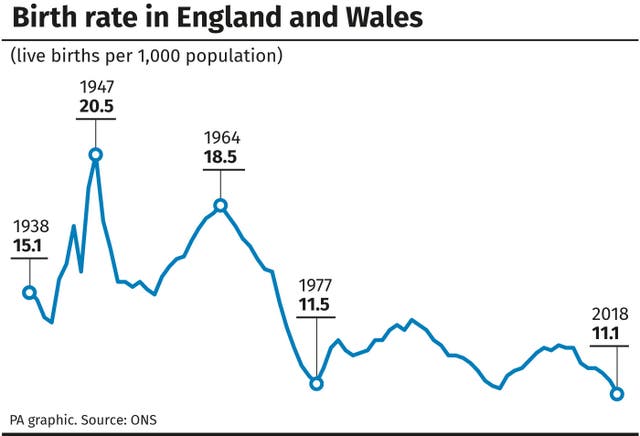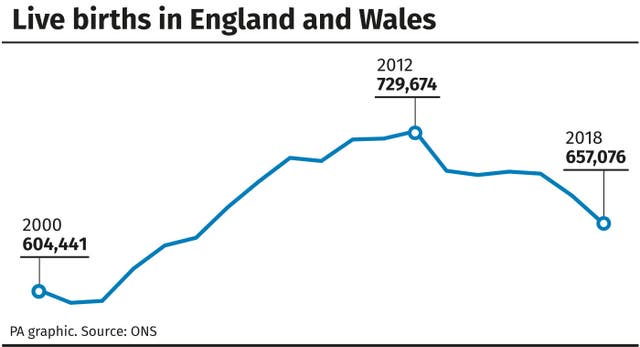
The birth rate in England and Wales has fallen to the lowest it has been for at least 80 years, official figures show.
There were 657,076 live births in 2018, a decrease of 3.2% since 2017 and 9.9% down since 2012.

It is the third year in a row that the number of live births has dropped and levels have not been this low since 2005, the Office for National Statistics (ONS) said.
The birth rate has hit a record low, decreasing from 11.6 to 11.1 live births per 1,000 people – the lowest since records began in 1938, the ONS said.
There were 657,076 live births in 2018 – fewer than every year since 2005 https://t.co/qcbLt1MnzP pic.twitter.com/8v0aeqBxvb
— Office for National Statistics (@ONS) August 1, 2019
The ONS said falling fertility rates were mainly responsible, but the fall could have been exaggerated by an ageing population, with a larger proportion of older people compared with those able to bear children.
The figures showed the stillbirth rate reached a record low for the second year running in 2018, with 4.1 stillbirths per 1,000 total births.
The stillbirth rate was the lowest level recorded for the second year running in 2018 in England and Wales, with 4.1 stillbirths per 1,000 total births https://t.co/Nnp6YXDOhB pic.twitter.com/Iej56xFYwQ
— Office for National Statistics (@ONS) August 1, 2019
There were 2,689 stillbirths in England and Wales in 2018 – a fall of 6.4% from the previous year.
The total fertility rate fell to 1.7 children per woman in England and Wales, a 3.4% decrease compared with 2017. This continues a six-year trend, the ONS said.

Fertility rates fell in women of all ages except those aged 40 and over, where they remained the same.
Rates were highest in the East of England, with 1.81 children per woman, while the North East remained with the lowest figure at 1.58.
Explore our interactive map to see how total fertility rates have changed over time in your area https://t.co/CAHpMc9sLZ pic.twitter.com/JDDHH7jT3h
— Office for National Statistics (@ONS) August 1, 2019
For the first time since 1990, the percentage of live births in England and Wales to mothers born outside the UK decreased, from 28.4% in 2017 to 28.2% in 2018.
Kathryn Littleboy, of the ONS’s Vital Statistics Output Branch, said: “Our analysis of births in England and Wales in 2018 paints a picture of decreases and some record lows. The birth rate was the lowest ever recorded, when births are measured as a proportion of the total population.
“The total fertility rate stood at 1.7 children per woman, lower than all years except 1977 and 1999 to 2002.
“The proportion of live births to non-UK mothers fell for the first time since 1990. The stillbirth rate reached the lowest level recorded for the second year running.
“There were 657,076 live births last year, the fewest since 2005 and a drop of almost 10% since 2012.”
Allan Pacey, professor of andrology at the University of Sheffield, said: “This trend almost certainly reflects the individual decisions by women and their partners about whether or not to have children (and if so how many), and supports the idea that economy and education are the best contraceptive.
“But it is likely to leave the UK and other countries like us with some interesting economic and social challenges in the years to come, because there will simply be too few young people of working age to support the economy and a disproportionate number of elderly people who require healthcare and pensions to be paid for.
“This makes our current reluctance to fund infertility treatments such as IVF for those who want children, but can’t, such a foolish and short-sighted decision by those in charge of healthcare budgets.”
Clea Harmer, chief executive at stillbirth and neonatal death charity Sands, said: “This continuing downward trend in the deaths of babies before birth is very welcome but, until the figures can be seen alongside mortality rates for babies who die shortly after birth, it is too early to comment on whether we are on track to meet the English Government’s ambition to halve deaths by 2025.”


Comments: Our rules
We want our comments to be a lively and valuable part of our community - a place where readers can debate and engage with the most important local issues. The ability to comment on our stories is a privilege, not a right, however, and that privilege may be withdrawn if it is abused or misused.
Please report any comments that break our rules.
Read the rules hereLast Updated:
Report this comment Cancel